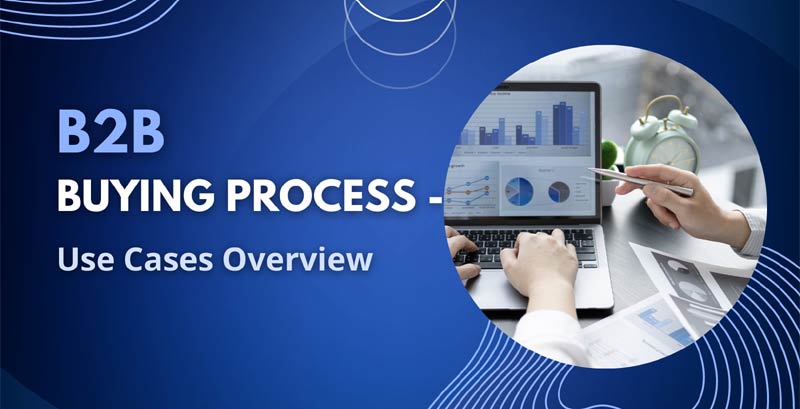eCommerce has been a revolution in the way consumers make purchases. It has changed how people shop, giving them access to more information and making it easier to compare products and prices. However, eCommerce is not just about shopping—it’s also about selling. This blog post will look at how eCommerce’s B2B buying process works.

Why B2B marketplaces are gaining popularity
Since eCommerce is becoming a part of many people’s daily lives, it is no surprise that it has become so popular in B2B markets. With the emergence of eCommerce marketplaces, it has become easier for businesses to find products and services without worrying about seeing them on their own.
In addition, these marketplaces offer a wide range of products from different suppliers and manufacturers in one place instead of having to look for each type of product separately from other sellers or suppliers.
What is the B2B buying process?
The B2B buying process is a series of steps buyers take to evaluate and purchase products or services. The steps in the B2B buying process vary based on the product or service being sold, but they typically include the following:
- Researching different solutions to find out what problems they are trying to solve.
- Creating a shortlist of potential solutions.
- Assessing each solution against their criteria for purchase. This includes determining whether it will meet their needs, how much it will cost them, and whether they can afford it. If yes, then they move forward with purchasing the product or service.
The B2B buyer’s journey is changing
In the past, the buying process for B2B was reasonably straightforward. A buyer would identify a need and approach an intermediary to help them source the needed product or service. This is still the case today, but it used to be more linear.
B2B buyers are becoming more tech-savvy; as such, they expect more from brands in terms of their online presence and user experience (UX). As a result, buyers want to buy products and services directly from suppliers—and they want them now. They also wish for transparency regarding price so they can make informed decisions about which supplier offers the best value for money.
The benefits of adopting B2B eCommerce
- Increased sales: More than 50% of B2B buyers turn to an eCommerce channel when they buy products or services.
- Reduced costs: eCommerce platforms are more cost-effective for B2B sellers than traditional channels like trade shows and exhibitions.
- Better customer experience: The online buying process provides customers with multiple interaction options such as live chat, email support, etc., which helps resolve their queries quickly and efficiently.
- Better brand perception: B2B companies can build a strong brand image by showcasing their products via eCommerce sites and building relationships with potential customers through social media marketing campaigns.
The benefits of B2B eCommerce marketplaces
In a B2B eCommerce marketplace, customers can buy from multiple suppliers, and suppliers can sell to various customers. As a result, the B2B eCommerce marketplaces offer attractive benefits for both sellers and buyers:
- A single platform for buyers and sellers to find each other.
- No need to go through multiple websites or apps to find the right supplier.
- An easy way to check out different options before making a purchase decision.
How to improve the online B2B buying process
- Improve the online B2B buying process to increase the number of leads.
- Improve the quality of leads to improve the conversion rate.
- Improve the average order value (AOV) and average customer lifetime value (CLTV) to increase revenue.
How to use B2B eCommerce marketplaces to attract more B2B customers
- Reach out to your customers on social media. Social media is one of the best ways to attract B2B customers, and it’s also a great way to keep in touch with them throughout the buying process.
- Use email marketing to reach out to customers. Email marketing is an excellent way for businesses to stay in contact with their customer base, especially if they’re already familiar with them.
- Use SEO (search engine optimization) techniques on your website so that you’ll show up higher in search results when someone searches for terms related to your industry or product line – people looking for what you’re selling will see it much more quickly.
- Pursue paid advertising using Google AdWords – this can help drive customers directly from their search engines to your website without having time for additional research beforehand. This is perfect because we all know how important first impressions are.
The more you know about your customers, the more likely you will make a sale
It’s critical to understand the customer’s buying process thoroughly. What is their decision-making process, and what are their needs? What are their business goals, and how will your product or service help them accomplish them? How much are they willing to pay for it?
Additionally, it would help if you considered how much time they have to spend on this decision-making process—and what other factors might affect their timeline. For example, a purchase may be easy if it’s just an hour or two from now but extremely difficult if the customer has many important tasks without any deadline.
Collecting this information can help refine your approach when selling B2B goods online. For example, you’ll know exactly what type of content and pricing structure will be most effective for each particular buyer, as well as which messaging style would resonate best with them based on what else is going on in their lives at that time (for example: Are they having a stressful day because of deadlines or family issues?).
Final thought
The buying process in eCommerce is a complex one, and it involves multiple steps. It’s essential to understand the different stages of this process to use them effectively when selling online. Your buyers may have different needs at each stage in their journey, so it’s critical to be aware of where they are in their decision-making process before engaging with them through your marketing efforts.



